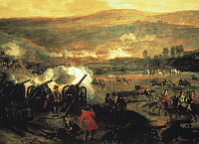Battle Artillery
The Williamite artillery train comprised more than thirty Dutch and English field guns and ‘field mortars’ (perhaps howitzers). The Jacobite train consisted of twelve French 4-pounders and four cannon sourced in Ireland. On the eve of the battle, in an exchange of artillery fire, King William was slightly wounded in the shoulder. During the battle, the Williamite cannon bombarded the Jacobite soldieries as they moved upstream. The ten Jacobite cannon at Oldbridge were withdrawn to safety before the Williamite attack. The six guns on their left wing checked the Williamite pursuit at Duleek. Only one was lost.
4lb Cannon & Limber (French)
- Long barrel version; barrel length: 2.58m; weight of gun and carriage: 1200 kgs.
- Transported by attaching the gun to a two-wheel limber, drawn by 3/4 horses in line.
- Fired solid 4.3 lb iron cannonballs and sometimes canisters of musket balls; maximum range: 2500m; effective point-blank range: 500m; best rate of fire: 20 shots per hour; working life: 1200 shots; gun-crew: 8
- 12 iron 4-pounders brought from France and deployed on Jacobite side at the Boyne.
3lb Falcon Cannon (Dutch)
- Barrel length: 2.2m; weight of gun and carriage: 600 kgs
- Transported by attaching the gun to a two-wheel limber, drawn by 2/3 horses in line.
- Fired solid 3 lb iron cannonballs and sometimes canisters of musket balls; maximum range: 2500m; effective point-blank range: 450m; best rate of fire: 20 shots per hour; working life: bronze indefinite, iron 1200 shots; gun-crew: 8
- 12 iron 3-pounders sent to Ireland in 1689 were probably still in service with the Williamite artillery at the Boyne; the Dutch artillery probably included 3-pounders which were standard regimental cannon in Holland.
6lb Saker Cannon (English)
- Barrel length: 2.9m; weight of gun and carriage: 1300 kgs
- Transported by attaching the gun to a two-wheel limber, drawn by 3/4 horses in line.
- Fired solid 6 lb iron cannonballs and sometimes canisters of musket balls; maximum range: 4000m; effective point-blank range: 500m; best rate of fire: 20 shots per hour; working life: bronze indefinite, iron 1200 shots; gun-crew: 8
- 4 bronze English sakers sent to Ireland in 1689 were probably still in service with the Williamite artillery at the Boyne.
Field Mortar (Dutch)
- Short barrel weapon, fired at 45 Degree angle; generally deployed with heavy artillery in siege warfare; a light version, or howitzer, had been developed in Holland.
- Transported on carts, from which the gun was lifted onto the ground for use.
- Fired large solid shot, stones, bombs and incendiaries; maximum range 1,000m
- 5 heavy mortars sent to Ireland in 1689; at the Boyne, the Williamites deployed a battery of Dutch light mortars/howitzers.

